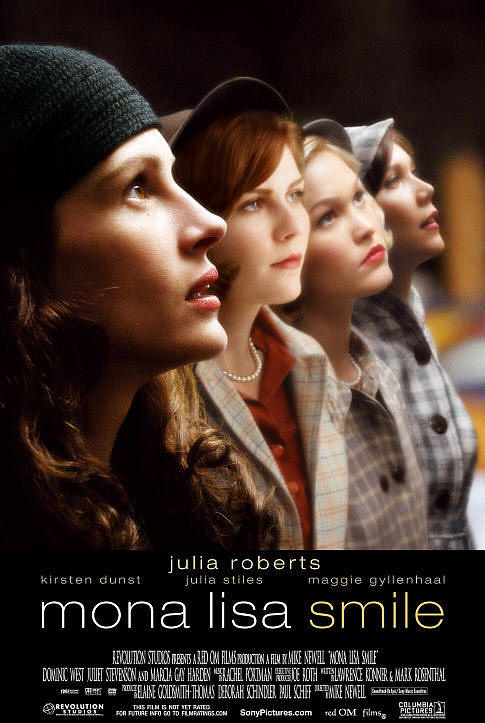Mona Lisa Smile
Reviewed by Rich Drees
 The years following World War Two were a time when social change was being
to ferment. Women, who had joined the workforce as part of the war effort in
addition to raising families while their husbands were fighting overseas,
were beginning to question the validity of the pre-War conceptions of their
roles in life. Itís at this time in history that some people feel the modern
feminist movement had its start and itís this time in history that the film
Mona Lisa Smile attempts to, albeit rather clumsily, examine.
The years following World War Two were a time when social change was being
to ferment. Women, who had joined the workforce as part of the war effort in
addition to raising families while their husbands were fighting overseas,
were beginning to question the validity of the pre-War conceptions of their
roles in life. Itís at this time in history that some people feel the modern
feminist movement had its start and itís this time in history that the film
Mona Lisa Smile attempts to, albeit rather clumsily, examine.
Katherine Watson (Julia Roberts) was not the first choice of Wellesley Collegeís administration to fill the position of art history professor. But after a previous candidate for the job accepted a position elsewhere, they are forced to hire her. But Katherineís progressive out look on life is not a smooth match with the schoolís overly conservative atmosphere, as she tries to encourage her students to be more than just the housewives and mothers that their 1950s society would have them be.
Chief among her students are Betty (Kirsten Dunst), editor of the schoolís newspaper and who is more than content to get married to her fiancťe as soon as possible, and her friend Joan (Julia Styles), who doesnít seem to understand Katherineís insistence that she can both get married and pursue a law degree. Another student, Giselle (Maggie Gyllenhaal) is having an affair with Italian professor Bill Dunbar (Dominic West) with whom Katherine will also become involved. As the school year progresses, Betty speaks out against Katherine both in class and in the student newspaper. Things become worse after Bettyís wedding when she finds her husband away on business more than he is home. Katherine finds herself torn between the man she left behind in California and her attraction to Bill.
If the story sounds familiar, itís because it bares more than a passing resemblance to 1989ís Dead Poets Society with a feminist message grafted on and Julia Roberts replacing Robin Williams in the progressive teacher out to inspire his or her students. While there is nothing wrong with the filmís desire to portray the 1950s as a time when women were trying to determine their place in society, itís just that the script does so in a rather clunky, ungraceful manner. The film goes out of its way to stress the point repeatedly and in many variations. Robertsí character repeated tells her students both in class and individually that they donít have to be bound by societyís expected roles for them but that they can be anything they want to be.
 The film also goes repeatedly out of its way to show how conservative the
Wellesley faculty is. Katherineís character is repeatedly told not to do
controversial things like teach about modern art or in any way to try and
deter her students from their path of becoming dutiful housewives. But in
itís zeal to illustrate this over and over, the script does make some
illogical choices. Early in the film, we are introduced to a member of the
schoolís faculty who gets fired for supplying students with birth control,
even though itís stated that it was an open secret for much of this
characterís 20-year tenure at the school that she was gay. I find it hard to
believe that if the school is as conservative and concerned about its public
appearance as the film wishes us to believe, that the characterís
homosexuality would have been tolerated for all that time.
The film also goes repeatedly out of its way to show how conservative the
Wellesley faculty is. Katherineís character is repeatedly told not to do
controversial things like teach about modern art or in any way to try and
deter her students from their path of becoming dutiful housewives. But in
itís zeal to illustrate this over and over, the script does make some
illogical choices. Early in the film, we are introduced to a member of the
schoolís faculty who gets fired for supplying students with birth control,
even though itís stated that it was an open secret for much of this
characterís 20-year tenure at the school that she was gay. I find it hard to
believe that if the school is as conservative and concerned about its public
appearance as the film wishes us to believe, that the characterís
homosexuality would have been tolerated for all that time.
Another troubling aspect in the filmís script is its dogged determination to give virtually every characterís storyline some sort of twist or reversal of fortune in the third act. By the time the credits roll, everyone seems to learn a life lesson like some over blown 1980s episode of The ABC After School Special. While some of these twists do make sense in the context of their individual storylines, by the time the third one is ready to rear its head, youíre already anticipating it.
The cast handles itself well, keeping the material from becoming too melodramatic, despite the insistences of the script. The 1950s period detail is accurate expect for Robertsí hair which looks much more modern. If itís an attempt to show that her character is ahead of her time, than itís a fairly heavy-handed one and potentially distracting for people who are interested in the period.